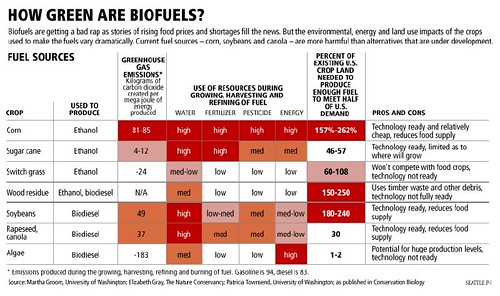U.S. to Require Fuel-Economy Standard by 2016. In addition to first ever nationwide regulation of greenhouse gases, plan would also raise the fuel efficiency target for new vehicles
(Source: Wall Street Journal & Politico via Yahoo)
WASHINGTON — The Obama administration plans to order auto makers to increase the overall fuel economy of automobiles sold in the U.S. to 35 miles per gallon by 2016, four years faster than current federal law requires, people familiar with the matter said Monday.
The move is part of a broader overhaul of fuel economy rules aimed at cutting greenhouse-gas emissions.
The Obama administration is expected to announce a plan to revamp federal vehicle fuel-efficiency standards to bring them into harmony with the goals of a California greenhouse-gas law. The Environmental Protection Agency and the Department of Transportation will jointly raise fuel-economy standards and reduce greenhouse-gas pollution under the plan.
Separately, auto makers have agreed to drop litigation challenging the legality of state-level curbs on tailpipe emissions of greenhouse gases, people familiar with the matter said.
An announcement of the agreement is expected Tuesday, with representatives of several large auto companies, including General Motors Corp. Chief Executive Fritz Henderson, and the president of United Auto Workers, Ron Gettelfinger, planning to participate, people familiar with the matter said.
The agreement worked out by aides to President Barack Obama represents a partial victory for the auto industry. The industry will be able to operate under a single national standard on fuel economy, rather than multiple regimes at the federal and state levels. Auto makers have long opposed California’s tailpipe emissions program as tantamount to state-level regulation of fuel economy, traditionally a federal responsibility.
But the standards will require huge investments by auto makers to remake their U.S. fleets so that they have roughly the same overall efficiency as vehicles they now sell in Europe, where gasoline is two to three times more expensive as in the U.S. By moving the 35 mpg requirement to 2016 from 2020, the administration is stepping up the pressure on the industry to overhaul its product lineup faster. It typically takes three to four years for auto makers to design and bring a new vehicle to market.
Auto executives are flying into Washington from around the world for the White House announcement. California Gov. Arnold Schwarzenegger, a Republican, is expected to attend, the sources said.
The CAFE standard was established by Congress in 1975 in response to the Arab Oil embargo. A 2007 energy law requires auto makers to boost the average fuel economy of their vehicle fleets to at least 35 miles per gallon by 2020, a 40% increase from the roughly 25 mpg standard for the current fleet. Last summer, the Transportation Department estimated that requiring auto makers to achieve 31.6 mpg by 2015 would cost the industry $46.7 billion, a sum the agency said would make it among the most expensive rule makings in U.S. history.
“This rule will be a down payment on a broader and sustained effort to reduce our dependence on foreign oil,” he said. “Going forward, my administration will work on a bipartisan basis in Washington and with industry partners across the country to forge a comprehensive approach that makes our economy stronger and our nation more secure.”
According to two industry officials familiar with the plan, mileage standards would rise slowly at first — from a combined requirement of 27.3 miles per gallon for cars and trucks in 2011 — and faster approaching roughly 35 miles per gallon in 2016. That would give auto makers more time to adjust — and collect credits if they can manage to exceed earlier targets — before the steeper increases kick in.
It is unclear how quickly the EPA and the Transportation Department’s National Highway Traffic Safety Administration will be able to make a formal proposal for curbing emissions and boosting fuel economy. The EPA on Monday was holding a public hearing on its proposal to find that greenhouse gases endanger public health, the first step toward regulating them.



 May 7, 2009-The National Hydrogen Association (NHA) and U.S. Fuel Cell Council (USFCC) issued the following joint statement regarding the Obama Administration’s FY 2010 budget request for the U.S Department of Energy:
May 7, 2009-The National Hydrogen Association (NHA) and U.S. Fuel Cell Council (USFCC) issued the following joint statement regarding the Obama Administration’s FY 2010 budget request for the U.S Department of Energy:






